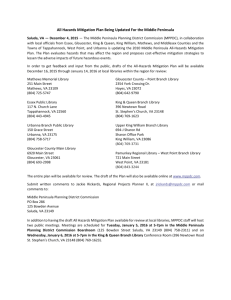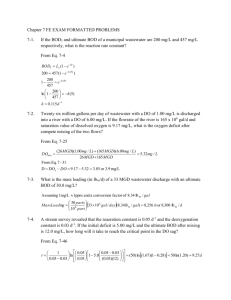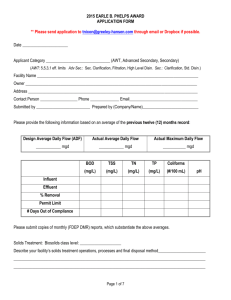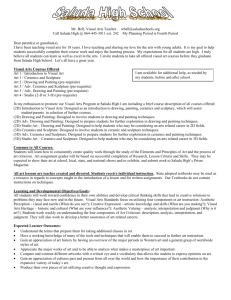Risk Relia
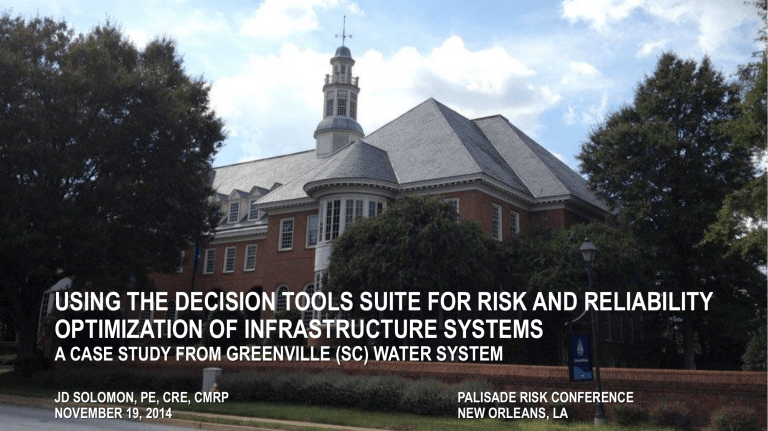
USING THE DECISION TOOLS SUITE FOR RISK AND RELIABILITY
OPTIMIZATION OF INFRASTRUCTURE SYSTEMS
A CASE STUDY FROM GREENVILLE (SC) WATER SYSTEM
JD SOLOMON, PE, CRE, CMRP
NOVEMBER 19, 2014
WBG052114205536FLL
PALISADE RISK CONFERENCE
NEW ORLEANS, LA
Overview
Summary of Use of Palisade Tools for Infrastructure Challenges
Case Study from Greenville (SC) Water System
•
Summary Presentation of Findings
•
StatTools
•
@Risk
Integration with Reliability Software
Summary Remarks
Palisade Tools to Help Solve Infrastructure Challenges
Long Range Demand Forecasting
•
Cary, Apex, Morrisville, and western Wake County
•
StatTools, @Risk
Systems Analysis and Optimization
•
Town of Clayton and Pharmaceutical
•
Town of Clayton, with links to county and another city
•
@Risk, TopRank, Evolver, and Optimizer
Emergency Capital Funding Forecasting
•
PRASA
•
@Risk, TopRank
Palisade Tools to Help Solve Infrastructure Challenges
System Renewal & Replacement Forecasting
•
Gwinnett County
•
@Risk, TopRank
Partnering Agreements
•
Marion County
•
Town of Clayton
•
PrecisionTree, @Risk, TopRank
Communications with Boards, Elected Officials, and the Public
•
Palisade Suite, especially graphics
WBG052114205536FLL
GREENVILLE WATER CASE STUDY:
SUMMARY OF BOARD PRESENTATION
Summary Observations
Question of capital improvements to North Saluda System is not “if” but “when”
Current capacity is sufficient for the intermediate term (5 to 10 years)
Some flexibility in terms of timing of capital improvements*
•
1 of 3 pumps required, and only required on limited basis
•
No significant breakdowns related to pumps
•
Local service providers believe they can keep at least 1 of 3 MCCs running
•
No significant failures related to transmission pipeline
•
GW is confident they can repair PCCP pipeline break in a couple of days
•
The system demands are not likely to shift upward significantly in short- to intermediate term
Mitigation planning around the most significant failure modes for highest risk system
Condition and costs associated with piping from intake to pump station require short-term
* 2009 Master Plan (CIP) recommended $5.8M in pump station electrical upgrades and generators in the short term; beyond 2015, $4.3M to replace pumps and $50.6 M for parallel transmission main
6
Summary Recommendations
Preventative Maintenance (PM) and Mitigation Plan – Sleeve Valve
Mitigation Plan – Motor Control Centers (MCCs)
Condition Assessment Intake to Station
Mitigation Plan – Intake to Station
Portable Generator Hook-up
Mitigation Plan – Pumps and Motors
PM Plan – Pumps and Motors
Mitigation Plan – Difficult Transmission Areas
MCC Replacement
Standby Generator
Parallel Transmission Line
Short-term
Short-term or
Intermediate
Longer-term
7
Seasonal Raw Water Supply Patterns – North Saluda
2007 2006 2008 2009
Drought Year
2011 2010 2012
“Normal” Weather
2013
TR 42” Construction TR 42” Online
TR 42” Online
System Orientation
Table Rock
North Saluda
1. 23 mgd gravity
3. 9 mgd pump
31-32 mgd total
2. 25 mgd gravity
4. 20 mgd pump (1 of 3 working)
Stovall
WTP
75 mgd of 95-100 mgd maximum day system demand
Targeted Reliability: 45 mgd
Note: North Saluda by permit can supply 63 mgd over 30 days; this would require 2 of 3 of the rated 30 mgd pumps to operate at 20 mgd each. This has never been needed.
9
Summary of Evaluation Process
Demand Projections
•
Deconstructed 2009 Master Plan Projections
•
Updated based on observations of past 4 years
•
Added a probabilistic component to address risk
O&M Review and Condition Assessment
StatTools
StatTools
@ Risk
•
Interviews, discussions, and site visits
•
Review of existing O&M records
•
Non-destructive evaluation using thermography and vibration analysis
•
Discussions with local service providers and vendors
Reliability Analysis
•
Reliability Block Diagrams
•
Fault Tree Analysis (FTA) and limited Failure Modes and effects Analysis (FMEA)
•
Calculations and modeling using ReliaSoft @Risk [& ReliaSoft]
Analysis of 2009 Master Plan –
Reconstruction of Demand Forecast
Data indicates more variability since around 1989-1990
The master plan used the 95 percentile estimate of gpcd
Relatively high peaking factor may also have overstated
MDD forecast
Probably in the range of 8 to 20 percent overstated
11
Analysis of 2009 Master Plan
12
Analysis of 2009 Master Plan –
Construction of our new Demand Forecast
13
Simulated Future North Saluda Raw Water Supply Pumping
2015-2022 Simulated Annual Raw Water System Operating Range
~95 th Percentile
(similar to 2007 pattern but with future demand)
Pumping Hours
5,500 hours
3,200 hours
1,000 hours
Reflective of a
3,200 hour pump operating scenario (2007)
Reliability - Defined
Reliability is the probability that an item will perform its intended function for a specified interval under stated conditions
Basic Reliability Mapping
Problem Statement
Reliability Block Diagram (RBD)
Fault Tree Analysis (FTA) – logic
Failure Modes and Effects Analysis (FMEA) - touched
Fault Tree Analysis – 1 of 3 Pumps (20 MGD)
17
Fault Tree Analysis – 45 MGD (25 MGD + 20 MGD)
Each Pump System has same components
18
Benefit of “1 of 3” versus Single Pump
One
1 of 3
19
Hourly Scatterplot Comparison of North Saluda and Table
Rock Raw Water Supplies
Dry Weather Year “Normal” Weather Year
2007
2009
Hourly Scatterplot Comparison of North Saluda and Table
Rock Raw Water Supplies
2012
Table Rock 42” Online
2013
Table Rock 42” Online
Failure Modes – All Flow Stops from North Saluda
(High Consequences)
North Saluda to Stovall WTP Transmission Line
•
Mode: Line collapses Repair Time: less than 1 week
(staff can perform)
Sleeve Valve at Stovall WTP
•
Mode: Valve fails closed or partially closed
Reservoir to North Saluda Transmission Line
•
Mode: Line Collapses
Repair time: Unknown
Repair Time: Unknown
22
Transmission Pipeline - Potential Problem Areas
Area 1: North Saluda Pump Station tie in
Area 2: Turn from US 25 to River Road
Area 3: River Road - North Saluda River too close for 2 nd pipe
Area 4: Crossing of SC Hwy 11
Area 5: Diagonal crossing of River Road
Area 6: Golf course
Area 7: Crossing of SC 414
Area 8: Road crossing at Bates Crossing Road
Failure Modes – Flow Above 27 MGD stops from N.S.
(Consequences High, but depends on operating scenario)
North Saluda Pumping (All)
•
Mode: Power Loss to Plant Repair Time: normally less than a few hours
North Saluda Pumping (single unit)
•
Mode: MCC Fails
•
Mode: Motor Fails
•
Mode: Pump Fails
Repair time: Unknown; switch to another unit
Repair time: Unknown; switch to another unit
Repair time: Unknown; switch to another unit
North Saluda Pumping (two units)
•
Mode: MCC Fails
•
Mode: Motor Fails
•
Mode: Pump Fails
Repair time: Unknown; switch to another unit
Repair time: Unknown; switch to another unit
Repair time: Unknown; switch to another unit
24
WBG052114205536FLL
StatTools
Our Approach
Dissected the 2009 Master Plan
Statistical Analysis of Historical Data – both sales and production
Analysis of How MP Demand Projections used the Historical Data
Reconstructed MP Demand Projections
Residential, Commercial, Wholesale, Unbilled Water, Population, Per Capita Use
Constructed our own 2035 Demand Projections
Probabilistic Analysis of 2009 MP
Probabilistic Analysis of our 2035 Demand Projections
Trued both based on 2010, 2011, 2012, and 2013 actuals
Forecasted impacts on North Saluda risk and reliability analysis
Analysis of 2009 MP – Statistical Analysis
1966-2008
1989-2008
Note:
Average Day R 2 :
1966-2008: 0.9176
1989-2008: 0.6762
Analysis of 2009 Master Plan – Historical Data
Statistical Analysis
6-, 12-, and 15-bin histogram generation
Lilliefors Test for normality
28
Analysis of 2009 Master Plan – Historical Data
The ADD data is more normally distributed than the MDD or MHD
20-year data is more normally distributed than the 10-year day
The MDD data appears to be significantly different post-1997 to 2008
Data suggests a meaningful degree of uncertainty related to MDD and MHD
29
WBG052114205536FLL
@Risk
Reconstructed Master Plan Projection
RECO N STRUC TION O F 2 0 0 9 MA ST E R P LA N
160.00
140.00
120.00
100.00
80.00
MP MDD
60.00
40.00
20.00
-
1 2 3 4 5 6 7 8
Actual MDD
9 10 11 12 13 14 15 16 17 18 19 20 21 22 23 24 25 26
Analysis of 2009 Master Plan –
Construction of our own Demand Forecast
32
Analysis of 2009 Master Plan –
Application to North Saluda
33
How we simulated future North Saluda Pumping Requirements:
Future Hourly Pattern
For North Saluda, 2015-2022
Annual
Pattern
For
Hourly
Flow
Probabilistic
Average Day
Forecast for
Entire
System
Raw Water Supply
Operational Rules
**Determine
Average Day
North Saluda
Demand
Simulated Future North Saluda Raw Water Supply Pumping
2015-2022 Simulated Annual Raw Water System Operating Range
Average operating conditions for 2006-
2013 (1,000 hour pumping/year)
Simulated Future North Saluda Raw Water Supply Pumping
2015-2022 Simulated Annual Raw Water System Operating Range
~95 th Percentile
(similar to 2007 pattern but with future demand)
Pumping Hours
5,500 hours
3,200 hours
1,000 hours
Reflective of a
3,200 hour pump operating scenario (2007)
Simulated Future North Saluda Raw Water Supply Pumping
2015-2022 Simulated Annual Raw Water System Operating Range
2 pumps operating Reflective of a
3,200 hour pump operating scenario (2007)
1 pump operating
A Few Observations
The current master plan is a deterministic model and provides no estimates of uncertainty or risk. For North Saluda, the master plan suggests that the system will require 2 of 3 pumps working on a regular basis at the present time. This is not remotely the case.
If uncertainty is accounted for in the current master plan, there would be an approximate 3 year range over which an outcome could be expected to occur.
Based on our analysis, the need for 2 of 3 pumps working at North Saluda on a possibility (approximately 5%) that 2 of 3 pumps will be needed regularly in 2016.
We estimate that there is an approximate 7 year range over which an outcome could be expected to occur.
Integration With Other Applications
WBG052114205536FLL
Infrastructure Risk and Reliability
Reliability calculations are dependent on a number of variables and probability distributions.
Current off-the-shelf software(s) do not have a probabilistic component
Palisade has developed an application for Fault Tree Analysis but still in the beta stage
For JD
•
Continue to work by sensitivity analysis with FTA and RBD reliability analysis
•
Will work with several upcoming projects with the Palisade
Summary Remarks
Palisade Suite continues to be a great tool for all types of infrastructure analyses and risk evaluations
Case study shared today demonstrates how the current offering can be used to support reliability analysis
Moving forward will continue to integrate the Palisade Suite, especially @Risk and StatTools, into reliability analysis
WBG052114205536FLL
JD Solomon, PE, CRE, CMRP jd.solomon@ch2m.com
THANK YOU
42
